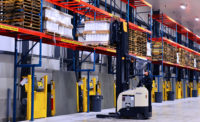With summer and hot weather comes the increased consumer demand for cold and frozen foods. In the realm of modern warehousing, optimizing efficiency and ensuring product quality are paramount. This is particularly true for cold and frozen warehouses where strict temperature control is essential. Implementing an Automated Storage and Retrieval System (ASRS) can offer significant advantages in such environments. From enhanced inventory management and space utilization to improved productivity and reduced operational costs, the advantages of automation in these specialized environments are substantial. By embracing technology and leveraging the capabilities of an ASRS, businesses can optimize their operations, ensure product quality and stay ahead in the competitive landscape of cold and frozen warehousing.
The Importance of Data
The first step in determining the requirements of any warehousing and distribution operation is data analysis. Regardless of a retrofit or new build project, the analysis considers everything when it comes to warehouse automation implementation. From inbound shipments to final order fulfillment, properly analyzed data reveals the areas of any operation that would benefit most from automation. It would be unfortunate to undergo the upfront costs of implementation to then find out that key pieces of information were not considered like paths for fork trucks, human access points for maintenance and repairs, and other critical business processes that create throughput or expiration concerns.
Turning raw data into user-friendly, easily digestible information can help in other ways like calculating inventory levels, spotting seasonality trends, eliminating silos and creating actionable data lakes, as well as identifying the most efficient rotation of pallets within a warehouse. It is vital to consider that the most common cause of poor automation design is missing or inaccurate data, and this can be a devastating black hole of expenses. Analyzing the data allows your automation vendor to customize the ASRS design to fit your specific business needs by width, height, and pallet size and storage lane depth. It can also provide guidance to commission the new automated system in phases should you be retrofitting an existing space and need to continue with daily operations.
Cost Justification for Automation
Automation is a major capital investment: to justify the costs there are several factors organizations should take into consideration like labor requirements, site conditions, inventory control, throughput and equipment shifts, and payback. Payback is typically seen within five years of implementing warehouse automation. Fortunately, the standard ASRS has a 25+ year life cycle. Within those 25 years, a company can expect to see savings from resulting factors like fewer damaged products, reduced labor costs, a smaller environmental footprint and lower maintenance costs.
After analyzing raw data and undergoing cost justification, there are several benefits that implementing an ASRS in a cold or frozen warehouse offer:
-
Maximum Space Utilization
Cold and frozen warehouses often face challenges related to limited space, as maintaining low temperatures requires thicker insulation and proper airflow. An ASRS can significantly maximize space utilization in such environments. These systems employ vertical storage solutions, utilizing high-rise racks and storage/retrieval machines to move pallets with speed and precision. By eliminating the need for traditional fork truck aisles and maximizing vertical storage capacity, an ASRS allows warehouses to store a higher volume of products within the same footprint. This not only optimizes space utilization but also enables better organization, reduces congestion and enhances overall warehouse layout. -
Improved Productivity
In a cold storage warehouse, manual handling of products can be time-consuming and physically demanding for employees. The implementation of an ASRS reduces the reliance on manual labor, leading to improved productivity. The automated system efficiently handles the movement and storage of products, reducing human error and expediting processes. By streamlining tasks such as order picking, storage and retrieval, an ASRS minimizes operational bottlenecks, enhances throughput and increases overall productivity. Moreover, with centralized control and real-time visibility into warehouse operations, managers can monitor performance, identify areas for improvement and make informed decisions to further optimize efficiency. -
Reduced Operational Costs
Implementing an ASRS in a freezer environment can result in substantial cost savings. First and foremost, the system reduces energy costs associated with manual material handling. By automating the storage and retrieval processes, companies can decrease the amount of space needing to be cooled as well as avoid the opening and closing of doors from temperature controlled spaces to ambient areas of a warehouse through the use of vestibules. Enhanced -
Inventory Management
Another advantage of an ASRS in a cold storage warehouse is the optimization of inventory management. The system utilizes advanced technologies such as barcode scanning and radio frequency identification (RFID) to track and monitor inventory in real time. This ensures accurate inventory control, minimizing the risk of errors and improving overall efficiency. The ASRS also provides automated inventory rotation, ensuring first in, first out (FIFO) and last in, first out (LIFO) rotations. By maintaining strict inventory control, companies can reduce waste and avoid stockouts while improving product quality and customer satisfaction.
Competition is fierce in cold storage: warehouse owners need to grasp every opportunity to stay a step ahead and automation is one of the best opportunities for improving operations. However, not all automation systems provide the same benefits. It is crucial to find a warehouse automation provider that puts data on a pedestal of importance and will prove cost justification prior to implementation. The vitality of data analysis cannot be overlooked and determines the failure or success of any automation project. By harnessing the power of data, warehouse owners can gain clarity on operations and ensure their automation system is working at max capacity. Without the data, they’re left hoping for the best.



